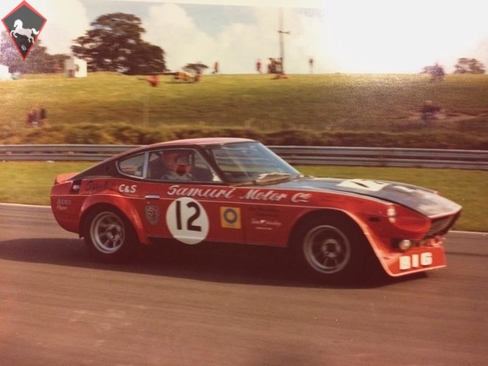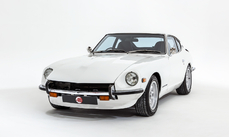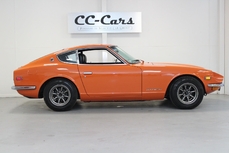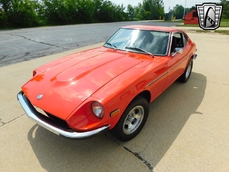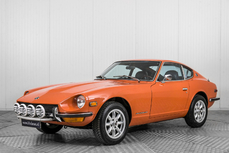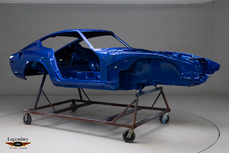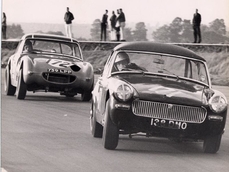Datsun 240Z Super Samuri 'Big Sam' 1972
Allgemeine Beschreibung :
By the late 1960s European and American car manufacturers had established a near strangle-hold on the global sports car market. To address this dominance, Nissan developed their Z-car range with the first of the series, the Nissan Fairlady-Z, or as the export version was known the Datsun 240Z, being introduced in late 1969. Combining good looks, and powerful performance, almost 150,000 units had been sold to the US alone by the time it was superseded (by the 260Z) in 1974 and it had become the world’s largest selling sports car.
To capitalise on its promising performance and make further inroads into the sports car market, Nissan unsurprisingly entered a small team of specially modified works cars into a number of International rallies, most notably in 1973 when Shekhar Mehta and Lofty Drews took victory in the East African Safari Rally.
Inspired by these performances, a number of private individuals recognised the latent potential in the 240Z and started to explore how they might be further developed. One of the more professional companies to undertake this work was the Samuri Motor Company, founded by Bob Gathercole and Spike Anderson, who went on to build around 74 examples of their uprated road going 240’s which they called the Super Samuri (a deliberate miss-spelling as the Super Samurai name had already been copyrighted). Not satisfied with building upgrades for road cars, in 1974 Gathercole and Anderson decided to develop a sports racing version of the Super Samuri, which would be built to Group 4 specification and entered into the 3 Litre class of the Blue Circle Modsports Championship.
The donor car they began with was a highly significant example in its own right being the ex-works 1970 RAC Rally car driven by Rauno Aaltonen. Gathercole and Anderson acquired this example with less than three weeks to go before their first race entry and so had their work cut out to get it ready for action. The car’s racing design was typical of the era with flared front and rear wings to cover enlarged Minilites, a deep front air dam and a rear spoiler. It also featured extensive use of perspex for the windows and fiberglass, which was used for the bonnet, doors and tailgate. The car, which had by now acquired the nickname Big Sam, was finished in the Samuri colours of Flame red and Rootes Tango metallic with White outlining.
Because of the tight timeframe before the first race the suspension and brakes received the majority of the mechanical work with the engine left largely in its original rally specification. In hindsight this was a mistake as the car blew a gasket in practice and the first race, at Silverstone in March, was actually run with Anderson’s road car acting as a substitute. In spite of this set-back the day turned out to be a success with the team’s driver, newcomer Win Percy, coming home first in class. At Croft, 24 hours later, Big Sam had a new gasket fitted and was soon showing its pace, moving quickly up the field into second position but sadly it was not to last and the car retired a few laps later with a broken rear main engine bearing. This was a far from ideal start to the season but the team soldiered on, building a new engine from assorted spares. The new unit had a much modified rear bearing, modified big-valve head and triple webers and showed a significant increase in power over the old rally spec engine. It performed well lasting until mid-season when it too expired at Llandow. By this stage Big Sam was proving to be something of an irritation to the Porsche Carreras, in spite of the 400cc the Datsun was giving away, and a real fight was on for the Championship. Following Llandow, Gathercole was fortunate to acquire another competition engine from fellow racer Bob Grant, which was rebuilt to incorporate all the learnings from the previous engine failures. This new unit had another big-valve head, triple 45DCOE webers, a one-off Gordon Allen crank, Carello Rods and 11:1 compression pistons from America. In this new form the engine produced 250 bhp and was good for 8000rpm, which was enough to take on the Porsches and the Championship points grew with almost every outing as Percy and Big Sam showed their true potential. Progress continued in this way until Brands Hatch on August 11th. Percy was pushing hard when he hit a patch of oil going into Bottom Bend. In the ensuing crash Big Sam’s shell was severely twisted and although Percy was relatively unharmed, the Datsun required a complete rebuild. With just over two weeks until the next race a fast fix was needed and the answer lay in another ex-works shell that Gathercole managed to acquire through Datsun UK. This particular car had been rallied by Shekhar Mehta in 1973. It is believed to have been used as a high speed recce and backup car on the Monte Carlo Rally as well as being loaned by the works to the Old Woking team for the Burmagh Rally in Scotland where it suffered a minor accident. It is not known for certain whether this shell was the same one used by Mehta on the Safari Rally but it is certainly possible. In any event it was this unit that was used to rebuild Big Sam with the bare shell being taken straight to the Samuri workshops and straightened up as far as possible within the limited time available. The ex-Aaltonen mechanicals were re-fitted and Big Sam was up and running in 10 days, a remarkable feat by any standards. The car made it to Castle Combe, but with almost no testing hours and still largely in primer. In spite of the rush Percy managed to secure a hugely important third place and with just two further races to go Porsche were becoming extremely worried about their championship chances. After another strong showing by Percy and Big Sam at Mallory Park in late September, an ex-works Carrera was provided to Nick Faure to help him secure the Championship for Porsche in the last race. The final showdown was at Thruxton on October 27th and was in many ways an anti-climax. The ex-works Porsche of Faure expired on lap three and Percy drove Big Sam to a comfortable 5th overall, which was enough to secure the Championship.
Gathercole and Anderson had different plans for the 1975 season and so Big Sam was sold on, ending up with Wolverhampton Datsun dealer John Bradburn, who lightened the car and hill climbed it with some success during 1976. Big Sam was next in action during 1981 when hand controls were fitted for the car to be raced by Martin Sharpe, formerly a motorcycle racer, who had been disabled in an earlier accident. Sharpe and Big Sam proved to be another successful pairing and at the end of the season they finished second in the BRSCC Championship behind the Marcos of Mark Hales.
Over the years following 1981 Big Sam was little used and stored until being acquired in 1989 by Nick Howell who commissioned Tim Riley and his engineering firm to undertake a full rebuild. This process has been well-documented in a number of magazine articles but it is important to stress that one of the key aims of the work was to preserve as much original material as possible. Consequently the original Mehta works shell was straightened and repaired and many fascinating original fittings were retained, such as the sump guard brackets on the chassis legs and the intercom mounts on the roll cage. A new engine was built, the last racing version having suffered yet another blow up in 1981, and the car was fully prepared for a return to competition. The first competitive outing for Big Sam was at Silverstone 1990 when Riley drove it to 3rd place overall. Further development work continued over the next year or two, including different final drive ratios and an overhauled gearbox. In spite of the occasional appearances on the track Big Sam maintained a relatively low profile until 2005 when it took part in the Goodwood Festival of Speed, driven by its owner Howell. A further appearance at Goodwood took place in 2010 when it was road tested at the circuit by Mark Hales. This was to be the last outing during Howell’s ownership and the Datsun was sold in Autumn 2010 to JD Classics who undertook further sensitive restoration and race preparation including installation of a JD developed High Torque engine. Since that time Big Sam has ramped up its appearances, running in the Legends Historic Touring Car Series at Portimao in 2011, Donington in 2011, 2012 and 2016 and taking part in the Bernina Hill Climb in 2015 and 2016 where it achieved a 2nd in class.
Now offered in full race ready condition and accompanied by an enormous history file, which includes full documentation of its period race history, numerous photographs as well as an abundance of letters, invoices and magazine articles, it offers an unrepeatable opportunity to acquire one of the most successful and iconic examples of the Modsport racing era and a truly historic ex-works Super Samuri Datsun. Please contact us for further details.
https://www.jdclassics.com/Cars/For-Sale/1972-Datsun-240Z-Super-Samuri-Big-Sam/3e7a6773-fcc3-47de-f58c-08d526a380ce
1972 Datsun 240Z Super Samuri 'Big Sam' is listed verkauft on ClassicDigest in Mayfair by JD Classics for Preis nicht verfügbar.
Fakten der Auto
Karosserietyp : Auto Marke : Datsun Modell : 240Z Ausführung : Super Samuri 'Big Sam' Hubraum : 2.4 Modelljahr : 1972 Lage : Maldon
Verkauft
Angaben Zum Verkäufer
Verkauft
People who viewed this Datsun 240Z also viewed similar Datsun listed at ClassicDigest
Other cars listed for sale by this dealer
über Datsun
Amerikanischen Markt versuchen!" Sie verschifften den Datsun 1000, ein Auto so winzig, dass selbst ein Clown es bequem fahren könnte. Amerikaner kratzten sich am Kopf, aber verliebten sich bald in seine kompakte Niedlichkeit. Es war, als adoptiere man einen kleinen, vierrädrigen Welpen.Mit dem Einzug der 60er Jahre enthüllte Datsun den 240Z, ein Sportwagen, der einen Samurai in Flip-Flops überholen konnte. Er hatte die Geschwindigkeit eines Geparden und ein Design, das Köpfe schneller drehte als ein Ninja auf Rollschuhen. Der 240Z wurde sofort zum Klassiker und zeigte, dass Datsun mehr war als nur eigenartige kleine Autos.
In den 70er Jahren brachte Datsun den 510 auf den Markt, eine Limousine mit der Agilität eines Ninjas und einer Federung so geschmeidig, dass man glauben konnte, man schwebe auf einer Wolke. Familien in ganz Amerika feierten ihn als das Auto, das alles transportieren konnte - von Lebensmitteln bis zu Omas - ohne ins Schwitzen zu geraten.
Aber die eigentliche Magie geschah, als Datsun den Datsun 510 Kombi vorstellte. Er war wie Mary Poppins' Tasche und fasste mehr als scheinbar menschenmöglich war. Dieser Kombi war ein Rätsel, ein Mysterium, und Amerika konnte nicht genug davon bekommen.
Dann, in den 80ern, machte Datsun einen cleveren Schachzug und änderte ihren Namen in Nissan und ließ uns alle ein wenig verwirrt zurück. Aber sie fuhren fort, fantastische Autos herzustellen, die flotter waren als ein Sushi-Koch an einem Samstagabend.
Und das ist die humorvolle Geschichte, wie Datsun - oder sollte ich sagen Nissan - den amerikanischen Markt erobert hat, ein eigenartiges, aber liebenswertes Auto nach dem anderen.
Was die einflussreichsten Datsun-Modelle und ihre technischen Daten betrifft:
Datsun 240Z: Der 240Z war eine Sensation im Sportwagenbereich. Er verfügte über einen 2,4-Liter-Reihensechszylindermotor, der etwa 150 PS leistete. Mit Heckantrieb und eleganter Optik war er ein Vergnügen zu fahren und ein Stilikone seiner Zeit.
Datsun 510: Der Datsun 510, erhältlich als Limousine und Kombi, war beliebt für sein Handling und seine Langlebigkeit. Er hatte in der Regel einen Vierzylindermotor mit rund 96 PS und war bekannt für seine agile Federung.
Datsun 510 Kombi: Der Datsun 510 Kombi war wie eine Tardis, mit einem täuschend geräumigen Innenraum. Er teilte den gleichen Motor wie die Limousine und bot außergewöhnliche Vielseitigkeit für Familien unterwegs.
Diese Datsun-Modelle hinterließen mit ihrem eigenartigen Charme, ihrer Leistung und ihrer Praktikabilität ein bleibendes Erbe und sind nach wie vor beliebte Klassiker in den Herzen von Autoenthusiasten und Familien gleichermaßen.
